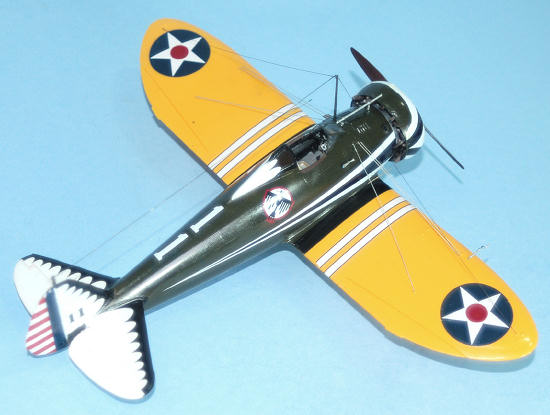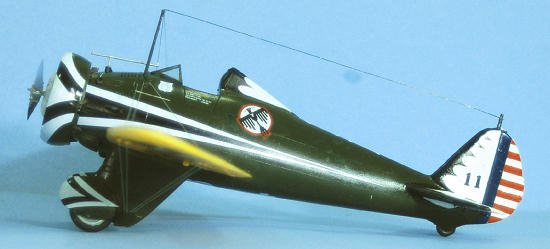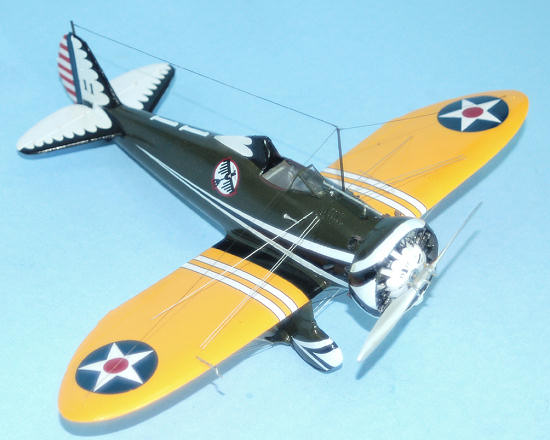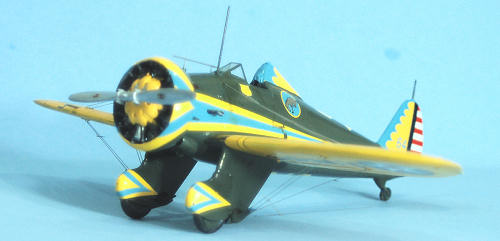
| KIT #: | ? |
| PRICE: | $Currently out of production |
| DECALS: | Two options |
| REVIEWER: | Tom Cleaver |
| NOTES: | Yellow Wings 32-022/35 decals used. Thanks to Bill Michaels for the kit. |

| HISTORY |
Billed for publicity purposes as the “revolutionary Boeing fighter,” the
Boeing P-26A was a mixture of old and new. The first all-metal monoplane fighter
to serve with the Air Corps, it was also the last USAAC fighter with
externally-braced wings, an open cockpit, and fixed undercarriage. It was also
the last Boeing-designed fighter, bringing to an end the company’s 15 year
domination of the fighter market for both the Army and Navy.
 Wright
Field during 1930-34 to aircraft built by private companies without government
funding but with Army-owned engines and other equipment on loan.
Wright
Field during 1930-34 to aircraft built by private companies without government
funding but with Army-owned engines and other equipment on loan.
The fixed undercarriage did add extra drag, but it had an advantage in
reducing weight and structural complexity and provided a structurally-efficient
low anchor point for the flying wires. The rear portion of each undercarriage
unit consisted of an inverted tubular bipod fastened to the front and rear wing
spars. The flying wires were attached to the apex, and the wheel pivoted about
the apex on an arm, with the landing loads being absorbed through a shock
absorber strut connecting the wheel axle to the front spar.
Demonstrating how different aircraft development was 70 years ago, the
P-26 project progressed from drawing board to first flight in only 9 weeks, when
the first XP-936 was flown on March 20, 1932, by test pilot Les Tower.
Manufacturer’s trials progressed so quickly that only 35 days later the
prototype was sent to Wright Field for Army evaluation on April 25.
 delivered, the XP-936 had a later
version of the same engine used by the P-12F, which gave the XP-936 only a 20 hp
advantage over the P-12F, and was also 39 lbs heavier than the P-12F.
Proving the superiority of the monoplane, it was 27 mph faster and
outclimbed the P-12F by 476 ft/min. Though the XP-936 outperformed many
contemporary Air Corps warplanes, it was
slower than the expected performance of the Martin B-10.
delivered, the XP-936 had a later
version of the same engine used by the P-12F, which gave the XP-936 only a 20 hp
advantage over the P-12F, and was also 39 lbs heavier than the P-12F.
Proving the superiority of the monoplane, it was 27 mph faster and
outclimbed the P-12F by 476 ft/min. Though the XP-936 outperformed many
contemporary Air Corps warplanes, it was
slower than the expected performance of the Martin B-10.

The second Model 281 demonstrator went to Spain in 1934, where the
Spanish government opted not to order any, but did buy the unarmed Model 281
demonstrator. Equipped with a pair
of Vickers machine guns in underwing pods, this Model 281 flew on the Republican
side in the Spanish Civil War and was finally shot down on October 21, 1938.
Following the U.S. entry into the war, the nine airworthy P-26s in the
Panama Canal Zone were replaced by P-40s in June, 1942. That November, the
Fuerza Aerea de Guatemala expressed interest in buying these P-26s. At the
time, Congressional rules forbade export of fighters to all Latin American
nations other than Brazil and Mexico. To get around this restriction, the
airplanes were identified on transfer documents as "Boeing PT-26A" aircraft, a
trainer designation actually used for the Fairchild Cornell. Seven P-26s were
transferred to Guatemala, with the last P-26 in American service - 33-89 -
transferred to Guatemala on May 4, 1943.
| THE KIT |
The P-26 has been popular with kit manufacturers since the airplane first
appeared. I remember building a
Guillow’s stick-and-paper P-26 with my Dad at an early age, a model that lasted
about a week in the hands of an active 7-year old.
A few years later, Aurora released the P-26 along with the P-6e.
These were the first “non-toy” models I ever built - in 1/40th scale,
they were both accurate in outline and detailed with separate control surfaces.
Both were re-released in the 1960sand 1970s by K&B Models, and in are
available today from kit collectors at prices considerably higher than the 69
cents each they originally sold for.
In 1/72 scale, Revell released a good P-26 model in the late 1960s that
can still be found. (Probably the best
in 1/72 is the Pavla kit that was released a few years back. Ed) Tom’s
Modelworks released a 1/48 vacuform in the late 1980s that made up into
 a nice
model, (and there is the old K&B/Aurora kit. Ed) but the definitive kit in 1/48 - and perhaps the best kit of the P-26 of
all - is the Hobbycraft kit released 12 years ago in three different versions.
This kit is well-detailed, and there are aftermarket sets by Eduard to
make it even better.
a nice
model, (and there is the old K&B/Aurora kit. Ed) but the definitive kit in 1/48 - and perhaps the best kit of the P-26 of
all - is the Hobbycraft kit released 12 years ago in three different versions.
This kit is well-detailed, and there are aftermarket sets by Eduard to
make it even better.
Hasegawa released their 1/32 P-26A 30 years ago, along with the P-12E,
F4B-4 and BF2C-1. These were the
best 1/32 kits available at the time, and are still the only kits in this scale
of these airplanes ever released. They were accurate and well-detailed, with
several markings choices available in the different releases over the following
years. There have been some limited
re-releases over the years, and the kits were distributed by Minicraft in the
late 1980s and early 1990s.
The kit is produced with the brittle plastic used by Hasegawa up to the
late 1980s, which leads me to wonder if they produced all these kits 30 years
ago, put them in storage and released them over the years.
The raised surface detail is very petite, and accurate for the P-26,
since the panels were lapped on the real thing.
The cockpit has adequate detail, but in this scale a modeler can put some
effort into super-detailing this area to good effect.
The engine is a jewel, making up into a very good-looking Pratt & Whitney
Hornet.
Overall, fit is excellent, with the only bad thing being a sink mark in the upper surface of the wingtips, due to the strange production method Hasegawa chose, with an inset lower wing half in this area. I had forgotten that this was endemic to the kit until reminded by a friend. This time, I filled that, sanded it smooth, and replaced the lost surface detail by rescribing the rivets with a pounce wheel. The truth is, this is not a really-apparent sink mark, and it would be virtually invisible under paint, unless viewed under light at the right angle. Were I doing it again I would leave it alone, and that is my advice to you.
| CONSTRUCTION |
 The kit is so well-engineered that - other than the mistaken filling of
the wingtip sink mark - I only used Mr. Surfacer on the centerline seam of the
fuselage and the seams where the two halves of the cowling are glued together.
The kit is so well-engineered that - other than the mistaken filling of
the wingtip sink mark - I only used Mr. Surfacer on the centerline seam of the
fuselage and the seams where the two halves of the cowling are glued together.
I assembled the engine and cowling, the fuselage, the wings and the
landing gear as separate sub-assemblies.
I left the cockpit as is, other than to add Eduard photoetch seatbelts -
remember that in the 1930s, American airplanes did not feature shoulder
harnesses.
The engine was painted and the cowling attached to it before painting.
With that done, the kit came together over a weekend and was ready for
paint.
| COLORS & MARKINGS |
 Painting:
Painting:
I painted the wings and tail Army Chrome Yellow (a different color than
Navy Chrome Yellow). This is a more
intense yellow than Insignia Yellow, obtained by using Tamiya Flat Yellow with a
bit of Orange added in. I then
painted the tail surfaces and the headrest with Tamiya Flat White, then after
masking the wings and tail, painted the fuselage, landing gear and cowling ring
with Tamiya “Olive Drab,” a green-base Oliver Drab that is very close to the
pre-war USAAC color, a very different “Olive Drab” than that used during the
Second World War. The propeller was painted with Auto-Air “Aluminum Base”.
Decals:
The real purpose of this review is not so much to review the kit as to
review the beautiful new Yellow-Wings decals.
The three sheets provide markings for one airplane of each of the three
squadrons of the 17th Pursuit Group, which was stationed at March
Field in 1934-35, and are among the best-known P-26As.
Sheet 32-022 covers the 34th Pursuit Squadron “The
Thunderbirds,” while sheet 32-033 covers the 73rd Pursuit Squadron
“Grizzlies”, and sheet 32-035 covers the 95th Pursuit Squadron
“Fighting Mules.” The decals are
full researched and perfectly printed by Micro-Scale.
I liked the sheets so well that I took my previously-assembled P-26A
model, stripped the fuselage and repainted it so I could do the 95th
Pursuit Squadron as well as this “new build” model of a “Thunderbirds” P-26A of
the 34th Pursuit Squadron.
I am sure in due time a “Grizzly” of the 73rd Squadron will
appear to join the others. These
decals are  available from Yellow Wings Decals are are highly recommended.
available from Yellow Wings Decals are are highly recommended.
There is one important point to be made, regarding the paint schemes of
these airplanes. Many reproductions
of 17th Pursuit Group airplanes have them with Blue-23 fuselages,
including the flying restoration done by Planes of Fame.
This is in fact not right, even if it does look very nice.
All P-26s came out of the factory in Olive Drab and Yellow, with the blue
fuselages done “in the field” after the change order in late 1935.
By the time the change order was made, the 17th Pursuit Group
had become the 17th Attack Group, and turned over all their P-26s to
the 1st and 20th Pursuit Groups.
All of the P-26s flown by the 17th Pursuit Group had Olive
Drab fuselages. I checked this with
my friend, aviation artist Robert Karr, who had researched the issue several
years ago for a painting, and he assured me that the correct color is Olive
Drab.
| FINAL CONSTRUCTION |
 Rigging was easy since the kit was produced with holes in the right
places to the model could be rigged with thread.
I used .010 stainless steel wire for this model.
Rigging was easy since the kit was produced with holes in the right
places to the model could be rigged with thread.
I used .010 stainless steel wire for this model.
I fitted the individual exhausts on the engine and attached the engine to
the airframe. These airplanes were
maintained in immaculate condition, so I did no weathering.
| CONCLUSIONS |
This kit is still the only game in town for a modeler who wants a P-26 in
this scale. Fortunately, it is a
kit that was ahead of its time in production quality as regards detail and fit,
and it has aged “like fine wine.”
Whether built out of the box or given the super-detailing treatment, this is an
excellent model.
Review kit courtesy Bill Michaels and my wallet. Decals courtesy of Yellow Wings Decals.
| REFERENCES |
Tom Cleaver
December 2006
If you would like your product reviewed fairly and quickly, please contact me or see other details in the Note to Contributors.